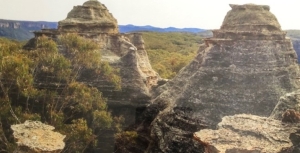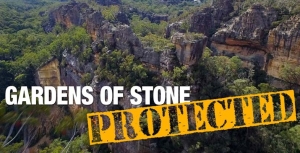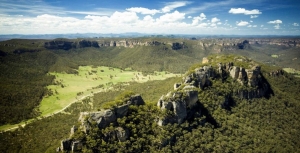Displaying items by tag: Gardens of Stone
Consultation on Gardens of Stone draft plans – should the area be a theme park or world class reserve?
In November 2021 the NSW government announced the creation of the Gardens of Stone State Conservation Area. This means this iconic area will be protected to some extent. The risk of further damage from coal mining has been averted but there is the prospect of over-reach with tourist development that could spoil the unique pagoda landscape. See our article on the history of the long campaign to protect this area.
A draft master plan and plan of management have now been released for submission.
The organisation that has been leading the campaign for the protection of this area is the Colong Foundation for Wilderness, now called Wilderness Australia. Click here for details of their many concerns about the proposals and a submission guide.
The closing date is 5 July. Send submissions to This email address is being protected from spambots. You need JavaScript enabled to view it. or Manager, NPWS Planning and Assessment, Locked Bag 5022, Parramatta, NSW 2124.
Potential features of the reserve
The Gardens of Stone State Conservation Area should become one of the best reserves in NSW. The diversity and rarity of its scenery and native flora, and its Aboriginal cultural heritage should be enjoyed by thousands. Lithgow could benefit from the increase in demand for accommodation and visitor facilities.
Wilderness Australia needs your help to ensure that happens, and that its values are not desecrated. Tourism needn’t cut the eyes out of the scenery with a muddle of disconnected and counterproductive proposals.
There are two separate documents under the consultation. A plan of management is statutory and cannot be changed without public consultation. The accompanying draft master plan for visitor management creates a parallel process that has no legal force and can be changed at the will of government. The two drafts do not work cohesively together.
The master plan’s list of intentions is more ambitious than the reserve’s visitor management budget can fund, so it provides no clarity on which park facilities will be built.
Major issues
The major concerns are:
- The main focus should be on nature-focused basic facilities like campgrounds, walking tracks, carparks and lookouts built on already disturbed land and serviced by good 2WD roads that everyone can use. The area is ideal for multi-day walking tracks with basic overnight campsites.
- There should be an emphasis on a 2WD park, with minor provision of 4WD trails where they can be managed sustainably. Instead, there is proposed exclusive 4WD vehicle access to iconic sites, such as Wolgan Falls and the Temple of Doom.
- It is proposed to locate the adventure tourism facilities, the zipline, via ferrata and 4WD access road, in the middle of the Lost City. This will cause a visual blight at Lithgow’s best scenic asset. It should be relocated to State Mine gully and encourage visitation to the State Mine and Railway Museum.
- The draft plan of management for the reserve is vague. Except for pest management strategies, it has few details on nature conservation action. There are no restoration management actions, apart from studies, to spend the very large biodiversity offset fund available for this work.
- Little is said about aboriginal community involvement in reserve management, including through economic opportunities and employment.
- There is too much emphasis on opportunities for private interests, such as private consultation with interest groups on facilities such as additional approved access routes for vehicles, horse and bike riders and up to four glamping accommodation hubs that are subject to secret lease negotiations. It seems the Wollemi Great Walk is being determined in secret by confidential contracts and leases negotiated for private ventures.
A revised, re-published and re-exhibited draft plan of management is required that defines the location and extent of proposed visitor facilities and access on a map, with criteria set out that ensure this work is done in a sustainable manner.
The role of the draft master plan must be to identify, through the public consultation, a set of visitor management actions to be published in a completely revised draft plan of management.
In May 2021 the NSW government announced that the Gardens of Stone will be declared a State Conservation Area. This means this iconic area will be protected to some extent. The risk of further damage from coal mining has been averted but there is the prospect of overreach with tourist development that could spoil the unique pagoda landscape. See STEP Matters, Issue 213 for the history of the long campaign to protect this area.
A draft Master Plan and Plan of Management have been released for submissions. The organisation that has been leading the campaign for the establishment of this national park is the Colong Foundation for Wilderness, now called Wilderness Australia. Click here for details of their many concerns about the proposals and a submission guide.
The closing date is 5 July. Send submissions to This email address is being protected from spambots. You need JavaScript enabled to view it. or Manager, NPWS Planning and Assessment, Locked Bag 5022, Parramatta, NSW 2124.
Potential features of the reserve
The Gardens of Stone State Conservation Area should become one of the best reserves in NSW. The diversity and rarity of its scenery and native flora, and its Aboriginal cultural heritage should be enjoyed by thousands. Lithgow could benefit from the increase in demand for accommodation and visitor facilities.
Wilderness Australia needs your help to ensure that happens, and that its values are not desecrated. Tourism needn’t cut the eyes out of the scenery with a muddle of disconnected and counterproductive proposals.
There are two separate documents under the consultation. A Plan of Management is statutory and cannot be changed without public consultation. The accompanying draft Master Plan for visitor management creates a parallel process that has no legal force and can be changed at the will of government. The two drafts do not work cohesively together.
The Master Plan’s list of intentions is more ambitious than the reserve’s visitor management budget can fund, so it provides no clarity on which park facilities will be built.
Major issues
The major concerns are:
- The main focus should be on nature-focused basic facilities like campgrounds, walking tracks, carparks and lookouts built on already disturbed land and serviced by good 2WD roads that everyone can use. The area is ideal for multi-day walking tracks with basic overnight campsites.
- There should be an emphasis on a 2WD park, with minor provision of 4WD trails where they can be managed sustainably. Instead, there is proposed exclusive 4WD vehicle access to iconic sites, such as Wolgan Falls and the Temple of Doom.
- It is proposed to locate the adventure tourism facilities, the zipline, via ferrata and 4WD access road, in the middle of the Lost City. This will cause a visual blight at Lithgow’s best scenic asset. It should be relocated to State Mine gully and encourage visitation to the State Mine and Railway Museum.
- The draft plan of management for the reserve is vague. Except for pest management strategies, it has few details on nature conservation action. There are no restoration management actions, apart from studies, to spend the very large biodiversity offset fund available for this work.
- Little is said about aboriginal community involvement in reserve management, including through economic opportunities and employment.
- There is too much emphasis on opportunities for private interests, such as private consultation with interest groups on facilities such as additional approved access routes for vehicles, horse and bike riders and up to four glamping accommodation hubs that are subject to secret lease negotiations. It seems the Wollemi Great Walk is being determined in secret by confidential contracts and leases negotiated for private ventures.
A revised, re-published and re-exhibited draft Plan of Management is required that defines the location and extent of proposed visitor facilities and access on a map, with criteria set out that ensure this work is done in a sustainable manner.
The role of the draft Master Plan must be to identify, through the public consultation, a set of visitor management actions to be published in a completely revised draft Plan of Management.
Gardens of Stone protected at long last
After 90 hard years of campaigning the NSW government has finally decided to declare some protection for the Gardens of Stone. The ideal would have been the creation of a national park but a state recreation area is a start. Here is some history:
- 1932, Colong Foundation for Wilderness founder, Myles Dunphy, included the Gardens of Stone in his ‘Greater Blue Mountains National Park Proposal’.
- 1985, former Colong Foundation Director, Dr Haydn Washington, published the Gardens of Stone Reserve Proposal.
- 1994 the liberal environment minister, Chris Hartcher, reserved the Gardens of Stone National Park (stage 1) after a strategic park proposal from the Colong Foundation for Wilderness while independents held balance of power in the NSW Legislative Assembly.
- 2005, the Gardens of Stone Alliance formed, consisting of the Blue Mountains Conservation Society, Colong Foundation for Wilderness and the Lithgow Environment Group to coordinate a community campaign to protect the Gardens of Stone based on a state conservation area proposal by the Colong Foundation. The campaign highlighted the damage being done to upland swamps and the pagoda formations by underground mining.
- 2019, a comprehensive visitor management plan, Destination Pagoda, was released by the Gardens of Stone Alliance to showcase the economic benefits of developing the tourism potential of the region.
- 2021, Centennial Coal withdrew their proposal for expansion of the Angus Place Colliery after persistent campaigning from the Gardens of Stone Alliance.
The total 30,000 ha of land to be protected has been drawn from several state forests and crown land. It includes threatened ecological communities such as upland swamps and box woodland and several rare and threatened species.
The campaigners have worked with the local Lithgow community, council and politicians to demonstrate the benefits of making the Gardens of Stone a tourist destination. Mining jobs will be replaced by new employment in the Lithgow area. The NSW government has come up with some financial support with $50 million for management and upgrades.
The drawcard is the amazing rock formations called pagodas that dot the landscape, with gorges, canyons and waterways winding between them. There are valleys with lush rainforest and high-country woodlands, including patches of snow gum. There are amazing wetlands that support unique wildlife like the giant dragonfly.
A state conservation area does not prohibit mining in the way that a national park declaration does. While Centennial Coal has withdrawn its proposal to expand the Angus Place coal mine, it still wants to extract coal and has submitted a new proposal to mine underground at Angus Place West. The prospect of more coal mining will be opposed strongly by conservation groups but at least the Gardens of Stone will not be affected.
The tourism developments include:
- An iconic great walk (six days) from the Wollemi wilderness through the Capertee Valley to the Gardens of Stone that will feature incredible views across the Wollemi wilderness and the ancient pagoda formations. Accommodation and purpose-built eco-cabins will be built along the way.
- Existing four wheel drive circuits will be retained.
- A 35 km mountain bike circuit.
- The Lost City Adventure project that will include Australia’s longest zip line and a spectacular elevated canyon walk.
- Upgraded roads and lookouts for the more sedate visitors
The challenge will be the potential damage from the expected influx to areas such as the Lost City and other rock formations, as well as indigenous rock shelters and other heritage. The design of these projects and management must give priority to protection of this unique area.
Haydn Washington has written about the history of the campaign, which you can download and read at your leisure History of the Campaign for Gardens of Stone from 1980 to 2021.
Destination Pagoda could be a Win for the Environment and the Lithgow Community
Lithgow coal miners want job security. Environmentalists want protection for the Gardens of Stone region’s upland swamps, endangered wildlife and the spectacular but fragile pagoda rock formations. Lithgow needs a boost to its economy. Centennial Coal has to pay millions as an ‘environmental offset’ for damage done to nationally significant and endangered upland swamps. They have identified the preferred swamp management program as reservation of the Gardens of Stone region. This is a no-brainer for a win-win situation.
The Colong Foundation, Blue Mountains Conservation Society and Lithgow Environment Group have launched a plan, called Destination Pagoda that will capitalise on this situation. The plan is to reserve the Gardens of Stone as a State Conservation Area to protect its pagodas and swamps. At the same time this designation will permit appropriate underground coal mining. New facilities will be created in the Lithgow area to develop tourism that will expand opportunities for visitors to experience the rock formations and aboriginal heritage of the area.
The plan will require a modest investment that will establish professional conservation management, improve access roads, develop visitor facilities, restore degraded areas, encourage visitors, support local enterprises and protect important values. The cost can be funded from Centennial Coal’s swamp offset funds of up to $14 million currently; mining company management of some roads and pest species, transfer of state forest expenditures to NPWS and Commonwealth and NSW government funds.
Getting the plan up has required much discussion. The process for getting a dialogue happening was facilitated by visits to Lithgow by unionists from the Combined Retired Union Members Association. Now the need is to get government support.
Events such as a bush dance in Lithgow on Saturday 23 November 2019 are being held to build the momentum of support for the plan.
The story about the campaign and the efforts to save the area are presented in Tom Zubrycki's documentary film called Gardens of Stone – A Living Landscape. The film will be screened on Tuesday 26 November at 6 pm at the Sydney Trades Hall Auditorium, Unions NSW, 4–10 Goulburn Street, Sydney – Gardens of Stone Alliance. For bookings contact Janine Kitson (0428 860 623, This email address is being protected from spambots. You need JavaScript enabled to view it.).
Letters to the local MP for Bathurst, Paul O’Toole will help.
For more details go to www.gardensofstone.org.au.



